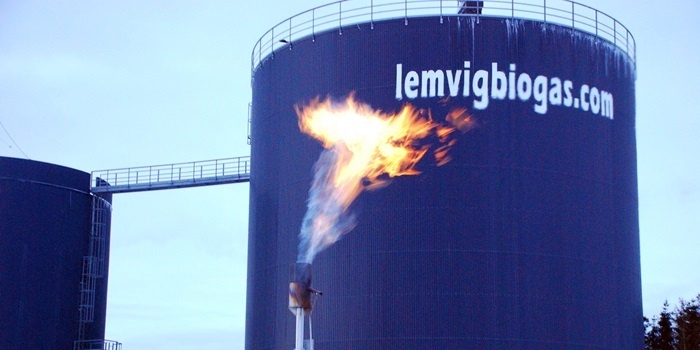News Release from windfair.net
Wind Industry Profile of
Denmark: From wind to gas
Wind turbines currently provide around 40 per cent of Danish electricity. Looking five years into the future, they will be able to supply more than half of Denmark’s electricity consumption. Thus, wind energy is without comparison the biggest contributor by far to a sustainable transition of the Danish energy sector. However, if we are to achieve the goal of Denmark becoming fossil fuel independent by 2050, we will have to find more ways to store the electricity from wind turbines.
This is the focus of the project MeGA-StoRE project (Methane Gas Storage for Renewable Energy), where DTU—in collaboration with Lemvig Biogas Plant—has tested a new method that basically involves using the biogas plant to convert wind energy into methane gas, which can subsequently be transferred to the natural gas grid.
“First and foremost, Megastore is an electricity storage project,” says Lars Albæk Kristensen, Director at Lemvig Biogas Plant.
The first step in the process is to convert the surplus wind turbine energy into hydrogen using electrocatalysis. In the next step, hydrogen is allowed to react with CO? in a reactor at the biogas plant to produce methane gas and water.
Although present in large quantities in the atmosphere, CO? is difficult to collect. However, the CO? can be removed at the biogas plant itself, where it would otherwise be emitted as a waste product. Biogas namely consists of methane and CO?.
The CO? content of the biogas is removed at the plant in order to produce the pure methane, which can then be added to the natural gas supply. Biogas is thus an excellent source of CO?, explains Lars Albæk Kristensen:
“Biogas contains 35 per cent CO? of an extremely high purity. And if we can store the surplus wind power energy in a carbon source such as methane, it'll be just like with oil: 100 per cent of what we put into the pipe, comes out the other end.” So if we use the hydrogen (which is made from surplus wind turbine electricity, ed.) to convert CO? into methane, we will have a carbon-based energy storage facility. And very close to 100 per cent of the CO2 is converted into chemically pure methane. We already have access to the infrastructure in the natural gas grid where we can store the energy. That’s the brilliance of the idea,” says Lars Albæk Kristensen.

So in contrast to the typical method where biogas is cleansed of CO? and the methane then transferred to the natural gas grid, the Lemvig Biogas Plant project has succeeded in capturing the CO2, allowing it to react with hydrogen. Not only did this utilize all the carbon in the biogas, it also increased methane production by approximately 50 per cent. The test facility at Lemvig Biogas Plant produced 24 m3 of biogas over a 24-hour period. The project must now be scaled up and will continue in the years ahead in a project at NGF Nature Energy on Funen, where the goal is to render the process even cleaner and more profitable.
"It'll be just like with oil: 100 per cent of what we put into the pipe, comes out the other end. "
Lars Albæk Kristensen, Director at Lemvig Biogas Plant
In other words, the experiment at Lemvig Biogas Plant is paving the way for efficient storage of wind energy in the natural gas network—and in the underground gas storage facilities, which contain sufficient gas to cover Denmark’s total gas consumption for several months.
This is clear evidence that biogas plants can play a key role in fossil-free energy supply—which is essential, says Professor Per Møller from DTU Mechanical Engineering, who is behind the Megastore project:
“Put a little crudely, with the help of biogas we are using the Danish fields to collect carbon from the atmosphere by means of photosynthesis—and with the help of wind energy, we can increase this yield by 50 per cent. Wind energy has already come a long way in Denmark. We’ve made the world sit up and take note—we’re the ones who came up with the solution. The next goal is to store the electricity so that in the future we don’t just sell wind turbines, but the complete system," says Per Møller, alluding to the fact that Denmark in future would also be able to export this storage technology.
- Source:
- DTU
- Link:
- www.dtu.dk/...

